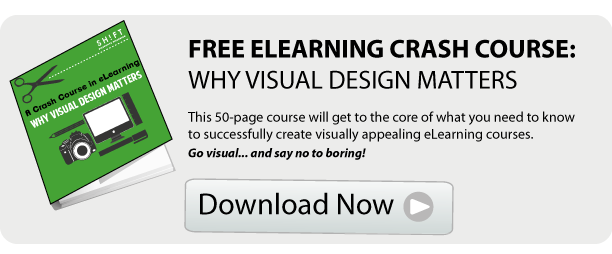Design is more pervasive than you think it is. The moment you fire up your eLearning tool and make a slide, you face issues of design whether you like it or not. And if you explore them a bit and find ways to improve a design, you become a designer yourself. You may primarily be a student, an author or a corporate executive. But you can effectively design an eLearning screen too.
As mentioned in our previous post, you only have to master the basics. Just that and your willingness to craft compelling courses. No fancy tools and complicated processes involved. You don’t have to buy PhotoShop and code in HTML, CSS and JavaScript.
Start designing eLearning courses like a pro instantly by learning these simple principles and techniques:

1) Begin with a Great First Impression
Your first screens should appeal strongly to learners. It should pique their interest and stimulate their imagination. Pay attention to your texts, images and other visual elements. Are they clear, catchy and relevant? They should be. People tend to ignore cluttered and boring design. They gravitate, instead, to one that’s aesthetically pleasing. Indeed, studies have revealed that the better the first impression, the the longer the participants will stay on the eLearning course.
Begin with a catchy course name. Then make your design appealing, consistent and user-friendly.
Make sure your first screens are clean, clear and well-designed. Focus on what you can give people throughout the course. Will the content help them become better at work or improve their skills at work? Tell them from the very beginning.
2) Highlight the Most Important Parts
An effective visual design leads viewers to the most important information. This is usually done with the help of typography, size, color and text placement. Thus, elements of the highest rank are most noticeable. They occupy headings and sub-headings and are usually typewritten in bold. They are arranged in such a way so that viewers can quickly skim through the slides and easily grasp your main points.
More importantly, give viewers a too obvious to be missed visual hierarchy. Structure or outline your content with bullet points, number lists, some brief quotes.
3) Think Subtract, not Add
“Perfection,” says the French writer Antoine de Saint-Exupery, “is achieved, not when there is nothing more to add, but when there is nothing left to take away.”
Like any other master artist, Saint-Exupery advocates subtraction—not addition. So in perfecting your screen, focus on removing unnecessary elements. Always resist the urge to fill every part of the screen. That’s the mark of a good designing in the making.
The point is to make your screen clutter-free. Clutter is the failure of design. The more element you add, the less effective the course becomes. Every occupied inch of space—no matter how pretty your images or eloquent your phrases are—decreases clarity and impact. Your slide turns into a slideument, not a real effective slide.
4) Consider the Human Brain’s Capacity
There’s another way to put it: respect the learner’s limitations. Since the brain can process only a limited amount of information at a time, giving learners too much of it is futile. For starters, to ensure success, content needs to be chunked. Sentences should be concise and simple words need to be used to facilitate information processing. These techniques will make learning more manageable and easier to integrate into long-term memory.
Storing new information, can be very difficult if there is no relevant information to store it with. So, make it easy for them to absorb and incorporate new information by placing content in context.
5) Design with Purpose
Intentional design is real design. In an intent-based eLearning design, elements are placed on a screen because they serve a purpose. This isn't mere decoration, where some or most elements creep into the slide just because it looks pretty or because you chose them on a whim.
Create an authentic learning experience through purposeful design. This requires designing your screen down to minute details. Does an element serve a purpose? Take it out if it doesn't. Every element must be there for a reason.
6) Consider the Rules of Good Image Selection
An image, indeed, tells a thousand words. But are you sure that an image represents the ideas you want to share? Be careful here. Too many eLearning materials out there are ruined by their bad selection of images. The image you choose can either make or break your presentation. Be sure to follow some of these rules:
- Use images that are directly relevant to the content.
- Limit the amount of images used to keep your slide clutter-free. One or two per slide is enough.
- Avoid lame clip art, watermarked images and cheesy stock photos
The ultimate rule is this: Always choose an image that will help reinforce, not ruin, your message.
7) Follow the Golden Rule: Alike, Together; Different, Apart
This rule is primarily about organization. It answers the question: how should you arrange the elements of a slide? Where should you place a title, text, image or whatever?
The golden rule implies proximity, which is one of the easiest ways to group things together. Proximity guides and helps learners in subconsciously understanding the content. By putting like elements together and different ones apart, you are at the same time creating a sense of organization. Remember, it’s part of your job to show learners what to think.




